Refer to our Texas Go Math Grade 8 Answer Key Pdf to score good marks in the exams. Test yourself by practicing the problems from Texas Go Math Grade 8 Lesson 12.4 Answer Key Algebraic Representations of Transformations.
Texas Go Math Grade 8 Lesson 12.4 Answer Key Algebraic Representations of Transformations
Your Turn
Question 1.
A rectangle has vertices at (0, -2), (0, 3), (3, -2), and (3, 3). What are the coordinates of the vertices of the image after the translation (x, y) → (x – 6, y – 3)? Describe the translation.
Answer:
Coordinates of the vertices of the image after the translation are:
A'(-6, -5);
B'(-6, 0);
C'(-3, -5);
D'(-3, 0).
The translation is 6 units to the left and 3 units down.
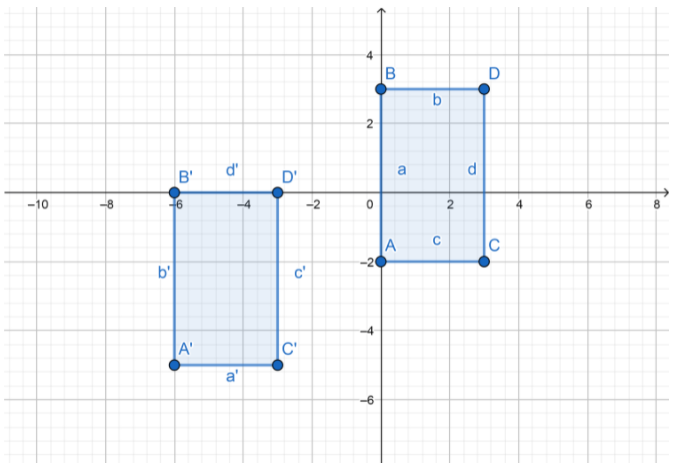
Question 2.
Triangle ABC has vertices A(-2, 6), 8(0, 5), and C(3, -1). Find the vertices of triangle A’B’C’ after a reflection across the x-axis.
Answer:
The vertices of triangle A’B’C’ after a reflection across the x-axis are:
A'(-2, -6);
B'(0, -5);
C'(3, 1).
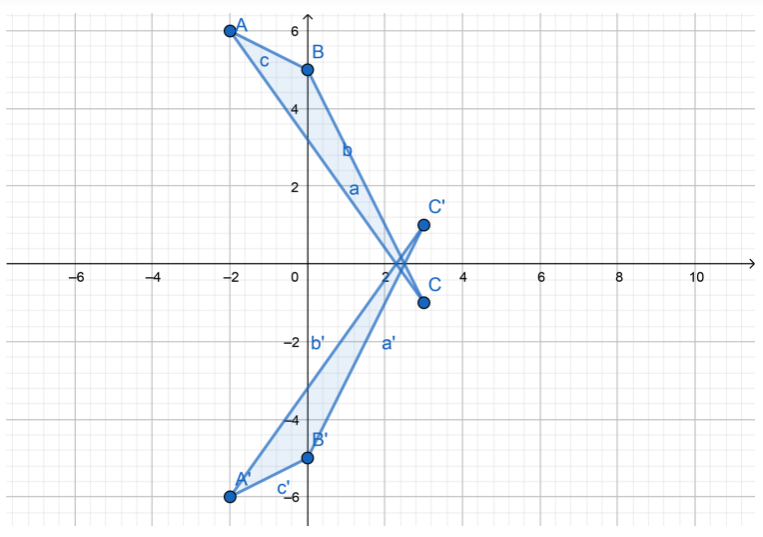
Reflect
Question 3.
Communicate Mathematical Ideas How would you find the vertices of an image if a figure were rotated 270° clockwise? Explain.
Answer:
If a figure is rotated 270° clockwise, it’s the same like the figure is rotated 90° counterclockwise. Multiply each y- coordinate by 1, then switch the x- and y-coordinates: (x, y) will be (-y, x).
Your Turn
Question 4.
A triangle has vertices at j(-2, -4), K(1, 5), and L(2, 2). What are the coordinates of the vertices of the image after the triangle is rotated 90° counterclockwise?
Answer:
Step 1: Apply the rule to find the vertices of the image. Multiply each y-coordinate by 1, then switch x- and y coordinates. (x, y) will be (-y, x).
For J(-2, -4) the image is J'(4, -2);
For K(1, 5) the image is K'(-5, 1);
For L(2, 2) the image is L'(-2, 2).
Step 2: Graph the triangle and its image.

Texas Go Math Grade 8 Lesson 12.4 Guided Practice Answer Key
Question 1.
Triangle XYZ has vertices X(-3, -2), Y(-1, 0), and Z(1, -6). Find the vertices of triangle X’Y’Z’ after a translation of 6 units to the right. Then graph the triangle and its image. (Example 1)
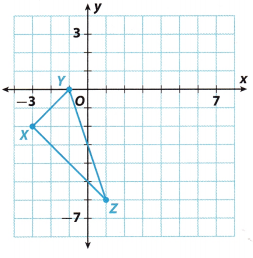
Answer:
Step 1: Apply the rule to find the vertices of the image. Add 6 to the x-coordinate (x, y) will be (x + 6, y).
For X(-3, -2) the image is X'(3, -2);
For Y(-1, 0) the image is Y'(5, 0);
For Z(1, -6) the image is Z'(7, -6).
Step 2: Graph the triangle and its image.
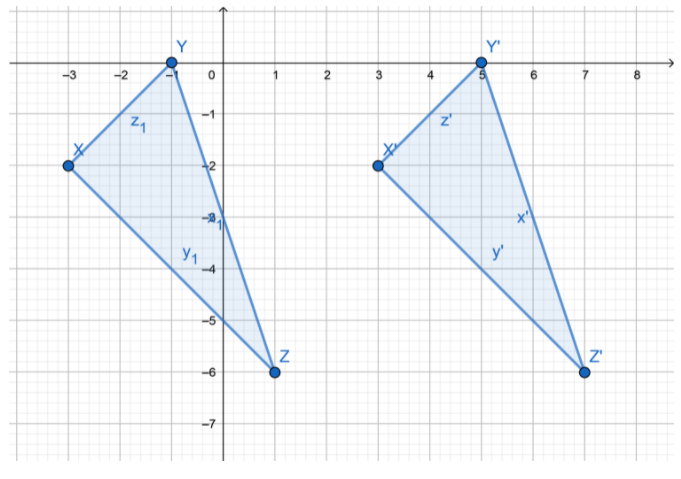
Question 2.
Describe what happens to the x- and y-coordinates after a point is reflected across the x-axis. (Example 2)
Answer:
After the point is reflected across the x-axis, the x coordinate does not change and the y coordinate is multiplying by 1.
(x, y) will be (x, -y)
Question 3.
Use the rule (x, y) → (y, -x) to graph the image of the triangle at right. Then describe the transformation. (Example 3)
Answer:
Step 1 Apply the rule to find vertices of the image.
A(-4, 2) → A'(2, 4)
B(2, 3) → B'(3, -2)
C(-3, 4) → C'(4, 3)
This means that transformation is rotation 90° clockwise.
Step 2: Graph the triangle and its image
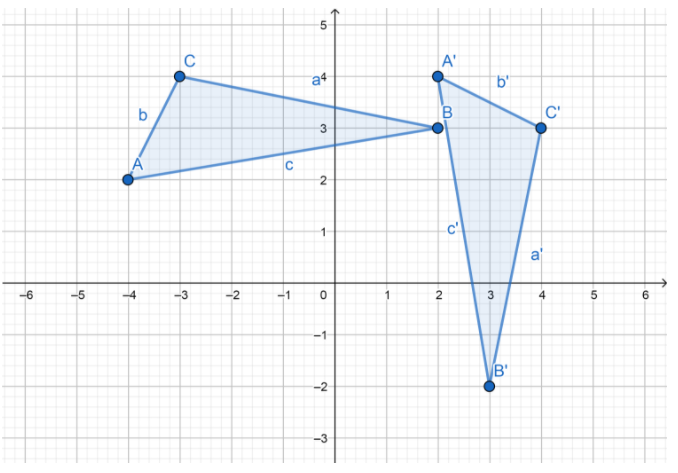
Essential Question Check-In
Question 4.
How do the x- and y-coordinates change when a figure is translated right a units and down b units?
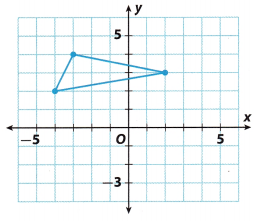
Answer:
The x-coordinates increase a units, and y-coordinates decrease b units.
Texas Go Math Grade 8 Lesson 12.4 Independent Practice Answer Key
Write an algebraic rule to describe each transformation. Then describe the transformation.
Question 5.
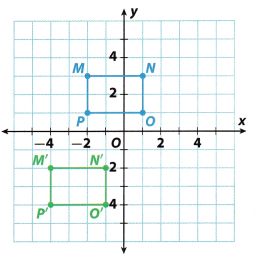
Answer:
The point (x, y) changes to (x – 2, y – 5). This is an algebraic rule.
The transformation is a translation of 2 units left and 5 units down.
Question 6.
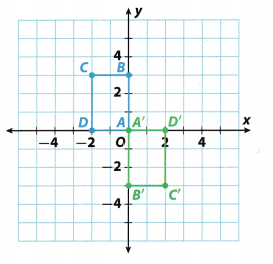
Answer:
The point (x, y) changes to (-x, -y). This is an algebraic rule.
The transformation is a rotation for 180°.
Question 7.
Triangle XYZ has vertices X(6, -2.3), Y(7.5, 5), and Z(8, 4). When translated, X’ has coordinates (2.8, -1.3). Write a rule to describe this transformation. Then find the coordinates of Y’ and Z’.
Answer:
X(6, -2.3) → X'(2.8, -1.3)
Find how changes coordinate x.
6 – a = 2.8
a = 6 – 2.8
a = 3.2
And how changes coordinate y.
-2.3 + b = – 1.3
b = 1.3 – (-2.3)
b = -1.2 + 2.3
b = 1
The rule is (x, y) → (x – a, y + b) where a = 3.2 and b = 1.
Apply the rule to find points Y’ and Z’.
Y(7.5, 5) → Y'(7.5 – 3.2, 5 + 1) So, Y’ has coordinates (4.3, 6).
Z(8, 4) → Z'(8 – 3.2, 4 + 1). So, Z’ has coordinates (4.8, 5).
Question 8.
Point L has coordinates (3, -5). The coordinates of point L’ after a reflection are (-3, -5). Without graphing, tell which axis point L was reflected across. Explain your answer.
Answer:
The reflection is across the y-axis, because coordinate x of point L changed sign.
Question 9.
Use the rule (x, y) → (x – 2, y – 4) to graph the image of the rectangle. Then describe the transformation.
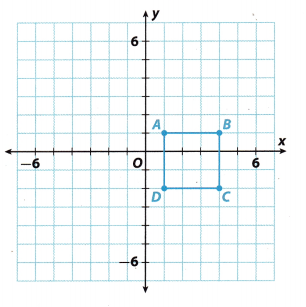
Answer:
Apply the ruLe (x, y) → (x – 2, y – 4) to find the vertices of the image A’B’C’D’.
A(1, 1) → A'(-1, -3)
B(4, 1) → B'(2, -3)
C(4, -2) → C'(2, -6)
D(1, -2) → D'(-1, -6)
The transformation is a translation 2 units left and 4 units down.
Graph the rectangle A’B’C’D’.

Question 10.
Parallelogram ABCD has vertices A(-2, -5\(\frac{1}{2}\)), 6(-4, -5\(\frac{1}{2}\)), C(-3, -2), and D(- 1, -2). Find the vertices of parallelogram A’B’C’D’ after a translation of 2\(\frac{1}{2}\) units down.
Answer:
The transformation is a translation of 2\(\frac{1}{2}\) down.
This means that y coordinate change.
Subtract 2\(\frac{1}{2}\) from the y coordinate.
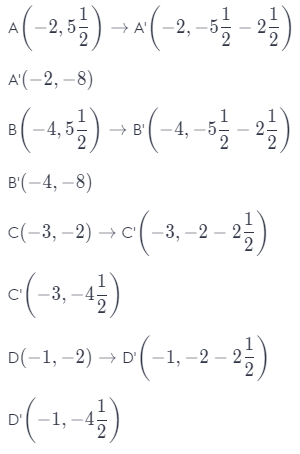
Question 11.
Alexandra drew the logo shown on half-inch graph paper. Write a rule that describes the translation Alexandra used to create the shadow on the letter A.
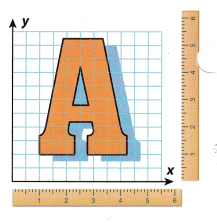
Answer:
The translation is 1 unit right and 0.5 unit down.
So, add 1 to the x coordinate and subtract 0.5 from the y coordinate.
The rule is:
(x, y) → (x + 1, y – 0.5)
One unit is one half inch.
So, the rule also can be add 0.5 inch (1 unit) to the x coordinate and subtract 0.25 inch (0.5 unit) from the y coordinate.
(x, y) → (x + 0.5 in, y – 0.25 in)
Question 12.
Kite KLMN has vertices at K(1, 3), L(2, 4), M(3, 3), and N(2, 0). After the kite is rotated, K’ has coordinates (-3, 1). Describe the rotation, and include a rule in your description. Then find the coordinates of L’, M’, and N’.
Answer:
K(1, 3) → K'( 3, 1)
From the point K’ we can see that the rule is:
(x, y) → (y, x)
and this is a rule for the rotation 90° counterclockwise.
Apply it to all points.
L(2, 4) → L'(-4, 2)
M(3, 3) → M'(-3, 3)
N(2, 0) → N'(0, 2)
H.O.T. Focus on Higher Order Thinking
Question 13.
Make a Conjecture Graph the triangle with vertices (-3, 4), (3, 4), and (-5, -5). Use the transformation (y, x) to graph its image.
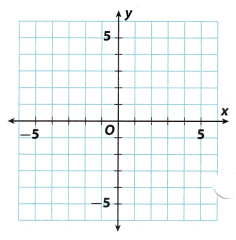
a. Which vertex of the image has the same coordinates as a vertex of the original figure? Explain why this is true.
Answer:

The point C’ has the same coordinates as a vertex C, because the transformation is:
(x, y) → (y, x) and vertex C has coordinates where x = y. If we replace them, we will get the same point C (-5, -5)
b. What is the equation of a line through the origin and this point?
Answer:
First find coefficient k, if:
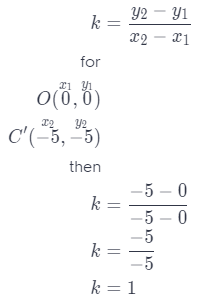
The equation of a line through two points (in this case O and C’) is:
y – y1 = k(x – x1)
y – 0 = 1 (x – 0)
y = x
c. Describe the transformation of the triangle.
Answer:
This transformation is a reflection across the line y = x, because the triangle ABC and A’B’C’ are the same distance from the line y = x, which is a line of reflection.
Question 14.
Critical Thinking Mitchell says the point (0, 0) does not change when reflected across the x- or y-axis or when rotated about the origin. Do you agree with Mitchell? Explain why or why not.
Answer:
Yes, applying the algebraic rules for the reflection and the rotation on the point O(0, 0), we will get the same point O.
For example reflection across the x-axis:
(x, y) → (x, -y)
(0, 0) → (0, 0)
This also applies to other transformations.
Question 15.
Analyze Relationships Triangle ABC with vertices A(-2, -2), B(-3, 1), and C(1, 1) is translated by (x, y) → (x – 1, y + 3). Then the image, triangle A’B’C’, is translated by (x, y) → (x + 4, y – 1), resulting in A”B”C”.
a. Find the coordinates for the vertices of triangle A”B”C”.
Answer:
First find the coordinates for the vertices B’ and C’.
Apply the rule (x, y) → (x – 1, y + 3).
A(- 2, 2) → A'(-3, 1)
B(-3, 1) → B'(-4, 4)
C(1, 1) → C'(0, 4)
Then apply the rule (x, y) → (x + 4, y – 1) on the coordinates of vertices A’, B’ and C’ to find the coordinates of vertices A”, B” and C”.
A'(- 3, 1) → A”(1, 0)
B'(-4, 4) → B”(0, 3)
C'(0, 4) → C”(4, 3)
b. Write a rule for one translation that maps triangle ABC to triangle A”B”C”.
Answer:
Subtract 1 from the coordinate x and then add 4.
Add 3 to the coordinate y, then subtract 1.
(x, y) → (x – 1 + 4, y + 3 – 1) (Simplify)
(x, y) → (x + 3, y + 2)